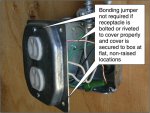HackElectric
Senior Member
- Location
- NJ
So let's say you have a 1900 box attached to a panel with a typical metal offset nipple. The box is now bonded.
You nut & bolt a GFCI to this type of cover and install it on the 1900 box:

Since the corners are flattened, you don't need an EGC running to the GFCI, is that correct?
You nut & bolt a GFCI to this type of cover and install it on the 1900 box:

Since the corners are flattened, you don't need an EGC running to the GFCI, is that correct?


